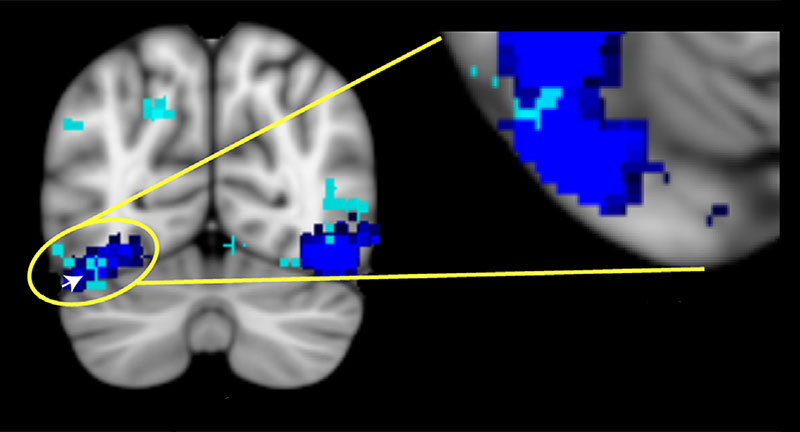
THIS ARTICLE IS MORE THAN FIVE YEARS OLD
This article is more than five years old. Autism research — and science in general — is constantly evolving, so older articles may contain information or theories that have been reevaluated since their original publication date.
Some children with autism show unique patterns of brain activation while solving math problems, particularly in a brain region normally used for face processing, suggests a study published 15 August in Biological Psychiatry1. They also seem to use more sophisticated mental strategies to solve these problems than do their typically developing peers, the researchers found.
“There have been a whole range of anecdotal reports of enhanced math skills in people with autism,” says lead investigator Vinod Menon, professor of psychiatry and behavioral sciences at Stanford University in California. “We wanted to take a close look at this in children to see: Are math skills really enhanced in children with autism? And if so, what’s the brain organization that might actually support this ability?”
Research on the cognitive strengths that children with autism possess has traditionally focused on their visual and spatial skills, rather than their mathematical abilities. A few studies have reported that children and adults with autism may have a special affinity and talent for math2, 3, 4, but these skills have not been rigorously studied or well understood.
“This study sheds light on a topic area that has been relatively underexplored in autism,” says Rajesh Kana, associate professor of psychology at the University of Alabama at Birmingham, who was not involved in the research. “We need more such studies replicating these findings.”
Arithmetic areas:
The researchers studied 18 children with autism — 14 boys and 4 girls between the ages of 7 and 12 — and 18 typically developing children who were matched for age, gender and intelligence quotient (IQ). All of the children with autism were verbal and had IQs within the normal range.
The scientists gave all the children a standardized math test and found that those with autism outscored the controls on measures of numerical and arithmetic ability.
To learn more about the children’s skills, the experimenters had each child complete 18 simple addition problems and then discuss how they’d solved each one.
In some cases, the children said they simply recalled the correct answer from memory. Other children used counting. And some children arrived at the answer by breaking each problem down into a set of simpler arithmetic questions, a relatively sophisticated strategy known as decomposition.
Children with autism, the scientists found, used decomposition 22 percent of the time — more than twice as often as their typically developing peers.
“From a cognitive point of view that’s interesting, and it tells us that the skills are not just memory-based retrieval,” Menon says. “It could be that they are actually at a more advanced stage of math development than their peers.”
The researchers also asked the children to complete a set of arithmetic problems as they lay inside a functional magnetic resonance imaging (fMRI) scanner.
Both groups of children engage the same brain areas when solving the problems, but those with autism show a unique pattern of brain activity. In particular, the researchers observed significantly different activity patterns in an area known as the ventral temporal-occipital cortex (VTOC), which processes visual information, including words, numbers, objects and faces.
The strongest group differences are in a part of the VTOC that normally processes faces. Activity patterns in this face-processing region are linked to individual differences in mathematical performance among children with autism: The more their neural patterns differ from those of the control children, the better their problem-solving skills. Brain activity in this region is not associated with math performance in typically developing children.
The VTOC is a highly plastic brain area, Menon says, meaning that it is particularly responsive to experience.Studies suggest that children with autism have deficits in facial processing and pay less attention to faces than typically developing children do5.
The new findings raise the possibility than in children with autism, brain areas normally used for processing facial information are recruited for other tasks, including math.
“There’s a lot of competition for this cortical space,” Menon says. It may be, he says, that “the plasticity in this area allows them to develop specialized expertise in areas such as math.”
Laurent Mottron, professor of psychiatry at the University of Montreal, praised both the study’s multi-pronged experimental design and its focus on strengths in children with autism.
“It’s a very good study both in its purpose and in its methodology,” says Mottron, who was not involved in the study. “The strong aspect is that they try to associate imaging and sophisticated behavioral performance, which not a lot of people do.”
However, Mottron cautions against reading too much into the finding that children with autism outscored IQ-matched controls on a standardized math test. The test used to assess IQ in this study, the Wechsler Abbreviated Scale of Intelligence, is a highly verbal test.
Mottron has shown that a longer, more comprehensive version of this test, the Wechsler Intelligence Scale for Children, underestimates the IQs of children with autism6. It may be that the children with autism in the new study in fact have higher IQs than the controls do, he says.
“Some autistic superiorities — not all, but some — result from matching them on a tool that underestimates their ability,” he says. “But this superiority is less interesting than the fact that they use their brain differently.”
References:
1: Iuculano T. et al. Biol. Psychiatry Epub ahead of print (2013) PubMed
2: Baron-Cohen S. et al. J. Autism Dev. Disord. 31, 5–17 (2001) PubMed
3: Baron-Cohen S. et al. Hum. Nature 18, 125–131 (2007) Abstract
4: Jones C.R. et al. Neuropsychology 23, 718-728 (2009) PubMed
5: Golarai G. et al. Clin. Neurosci. Res. 6,145-160 (2006) PubMed
6: Dawson M. et al. Psychol. Sci. 18, 657-662 (2007) PubMed
By joining the discussion, you agree to our privacy policy.